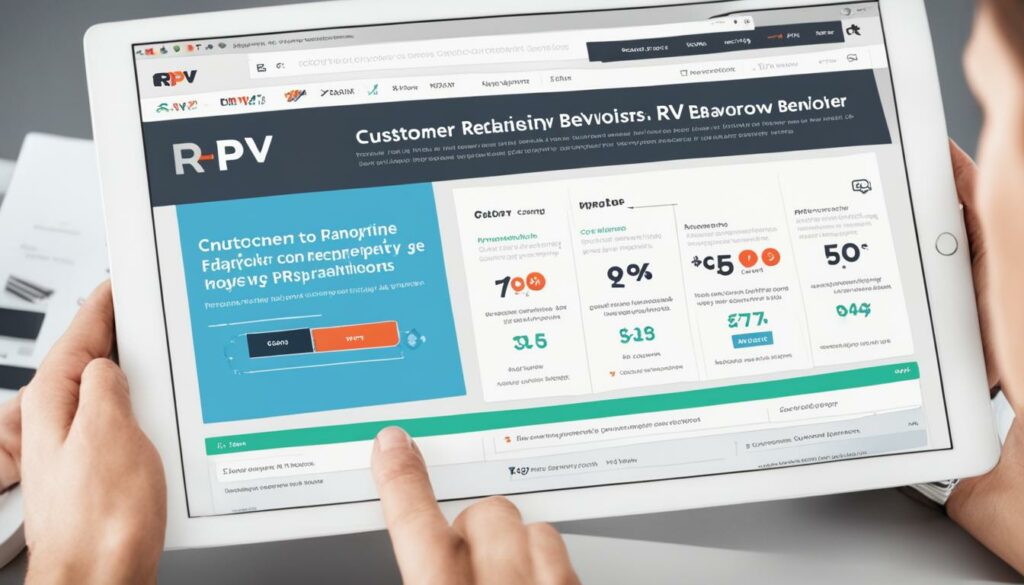Revenue Per Visitor (RPV) is an essential metric for eCommerce businesses to understand the value that each website visitor brings to their business. RPV measures the average revenue generated from each visitor and is calculated by dividing the total revenue by the total number of visitors. It is a comprehensive metric that provides insights into the effectiveness of the eCommerce strategy and helps optimize marketing efforts. RPV complements other metrics like conversion rate and average order value to provide a complete picture of the business’s performance.
Improving RPV can be done by increasing the number of visitors or by increasing the amount spent by each visitor through strategies like bundling, cross-selling, upselling, and offering free shipping. Monitoring RPV helps businesses identify areas for improvement and make data-driven decisions to increase revenue and optimize their online store’s performance.
Key Takeaways:
- RPV measures the average revenue generated from each website visitor in eCommerce.
- It is calculated by dividing the total revenue by the total number of visitors.
- RPV provides insights into the effectiveness of eCommerce strategies and helps optimize marketing efforts.
- Improving RPV can be achieved by increasing the number of visitors or the amount spent by each visitor.
- Monitoring RPV helps identify areas for improvement and make data-driven decisions to increase revenue.
The Importance of Revenue Per Visitor in Ecommerce
Revenue Per Visitor (RPV) is an important metric in ecommerce that provides valuable insights into the effectiveness of an online store’s revenue generation. Unlike other metrics like conversion rate and average order value, RPV takes into account both the number of conversions and the average order value to provide a comprehensive view of the revenue generated per visitor.
By tracking RPV, businesses can evaluate the success of their marketing efforts and understand the behavior of their website visitors. This metric helps identify opportunities for growth, optimize marketing strategies, and make data-driven decisions to increase revenue in ecommerce.
RPV plays a crucial role in understanding the performance of an online store. It not only measures the value each visitor brings to the business but also highlights the effectiveness of the overall ecommerce strategy. By analyzing RPV, businesses can identify areas for improvement and make informed changes to optimize their online store’s performance.
Relation to Other Ecommerce Metrics
RPV works in conjunction with other ecommerce metrics, such as conversion rate and average order value, to provide a holistic understanding of the business’s performance. While conversion rate measures the percentage of website visitors who make a purchase, RPV goes further by considering the average order value as well.
For example, if a website has a high conversion rate but a low average order value, the overall RPV may be lower compared to a website with a lower conversion rate but a higher average order value. This demonstrates the importance of combining metrics to gain a comprehensive view of revenue generation in ecommerce.
By analyzing the correlation between RPV, conversion rate, and average order value, businesses can identify areas for improvement and implement strategies to increase revenue per visitor. This data-driven approach allows for targeted optimizations that can lead to significant growth and maximization of revenue potential.
Calculating Revenue Per Visitor in Ecommerce
Calculating Revenue Per Visitor (RPV) in ecommerce is a straightforward process that provides valuable insights into the revenue generated by each visitor. To calculate RPV, simply divide the total revenue generated during a specific period by the total number of visitors to your website. The formula for calculating RPV is as follows:
RPV = Total revenue / Total number of visitors
This calculation gives you the average revenue value for each visitor to your website. By tracking RPV regularly, you can understand the effectiveness of your marketing strategies and identify areas for improvement. Monitoring RPV helps you make data-driven decisions to optimize your revenue generation strategies and maximize your ecommerce success.
To illustrate, let’s consider an example:
| Period | Total Revenue | Total Visitors | RPV |
|---|---|---|---|
| January 2022 | $50,000 | 10,000 | $5 |
| February 2022 | $60,000 | 12,000 | $5 |
In the example above, the RPV for January 2022 and February 2022 is calculated by dividing the total revenue by the total number of visitors. Both months have an RPV of $5, indicating that each visitor generated an average revenue of $5. By monitoring RPV over time, you can identify trends and measure the impact of your marketing efforts on revenue generation.
Tracking RPV is essential for optimizing your ecommerce strategy and driving business growth. It provides a comprehensive view of your website’s performance and helps you make informed decisions to increase revenue per visitor.
Strategies to Improve Revenue Per Visitor in Ecommerce
Improving Revenue Per Visitor (RPV) is crucial for ecommerce businesses looking to maximize their revenue potential. By implementing strategic tactics, businesses can enhance the value each visitor brings to their online store. Let’s explore some effective strategies to improve RPV in ecommerce:
- Increase website traffic: Targeted marketing campaigns and search engine optimization (SEO) techniques can help attract more visitors to your website. By optimizing your online presence, you can increase the number of potential customers who interact with your products or services.
- Implement upselling and cross-selling techniques: Encourage customers to spend more by suggesting complementary or upgraded products. By strategically placing related items or offering product bundles, you can increase the average order value and improve RPV.
- Provide incentives: Offering incentives such as free shipping or exclusive discounts can motivate customers to make larger purchases, thereby increasing RPV. These incentives create a positive shopping experience and encourage customers to return in the future.
- Optimize the website and sales funnel: Streamline the purchasing process by enhancing website navigation, improving product descriptions, and simplifying the checkout process. By reducing friction and making it easier for customers to make a purchase, you can increase the conversion rate and ultimately improve RPV.
Implementing these strategies can help businesses improve RPV in ecommerce and drive their revenue growth. By constantly analyzing the data and making data-driven decisions, businesses can optimize their marketing efforts and enhance the overall performance of their online store. Remember, improving RPV requires a holistic approach that considers both attracting new visitors and maximizing the revenue generated from each individual visitor.

Understanding Customer Behavior in Relation to RPV
Revenue Per Visitor (RPV) in ecommerce provides valuable insights into the purchasing habits and preferences of website visitors. By analyzing RPV, businesses can gain a deep understanding of how customer behavior affects their revenue generation. Various factors, such as product pricing, discounts, and incentives, influence customer behavior and purchasing decisions, ultimately impacting RPV.
For example, offering product bundles or upselling complementary items can increase the average order value and improve RPV. Understanding customer behavior in relation to RPV allows businesses to tailor their marketing strategies and optimize their online store according to customer needs and preferences.
By leveraging RPV data, businesses can identify trends and patterns in customer behavior and make informed decisions to drive revenue growth. Analyzing RPV in conjunction with other ecommerce metrics, such as conversion rate and average order value, provides a comprehensive view of the business’s performance and helps identify areas for improvement.
The Role of Customer Behavior in RPV Optimization
Understanding the customer journey is crucial for optimizing RPV in ecommerce. By studying how customers navigate through the website, which products they interact with, and what factors influence their purchasing decisions, businesses can create a personalized and seamless online shopping experience.
Customer behavior plays a significant role in RPV optimization by enabling businesses to:
- Identify popular products or categories that drive higher revenue
- Offer relevant product recommendations and personalized promotions
- Implement targeted marketing campaigns based on customer preferences
- Improve website navigation and user experience
By aligning marketing strategies with customer behavior insights, businesses can enhance RPV and create a loyal customer base that generates consistent revenue.
Customer Behavior Metrics and Analysis
Measuring and analyzing customer behavior metrics allows businesses to gain deeper insights into RPV optimization opportunities. Key customer behavior metrics include:
| Metric | Description |
|---|---|
| Bounce Rate | The percentage of visitors who leave the website after viewing only one page. High bounce rates may indicate a disconnect between visitor expectations and website content. |
| Time on Page | The average amount of time visitors spend on each page. Longer average times may suggest higher engagement and interest. |
| Conversion Rate | The percentage of visitors who take a desired action, such as making a purchase or signing up for a newsletter. Higher conversion rates indicate more effective marketing and website optimization. |
| Cart Abandonment Rate | The percentage of visitors who add items to their cart but do not complete the purchase. High abandonment rates may indicate issues with pricing, shipping costs, or checkout process. |
By analyzing these metrics alongside RPV, businesses can identify areas for improvement and develop targeted strategies to optimize customer behavior and increase revenue.

Challenges and Considerations for RPV in Ecommerce
When it comes to measuring the success of an ecommerce business, Revenue Per Visitor (RPV) is a crucial metric. However, businesses need to be aware of the challenges and considerations that come with using this metric effectively.
One of the main challenges is the complexity of accurately calculating RPV. It requires tracking and analyzing various data points, such as total revenue and total number of visitors. Business owners and marketers need to ensure that they have accurate and reliable data to calculate RPV accurately and make informed decisions based on the results.
Another consideration is the impact of different marketing strategies on RPV. Businesses strive to increase website traffic to attract more visitors, but they also need to maintain a high average order value. It is essential to find the right balance between these two factors to optimize revenue generation. Continuous monitoring of RPV and adjusting marketing strategies accordingly is key to achieving this balance.
Moreover, businesses should take external factors into account when analyzing RPV. Market trends and competition can greatly influence a business’s RPV. By keeping an eye on these factors, businesses can better understand and respond to changes in their industry, ensuring that their marketing strategies align with the current market conditions.
FAQ
What is RPV in Ecommerce?
RPV stands for Revenue Per Visitor. It is a metric that measures the average revenue generated from each visitor to an ecommerce website.
How is RPV calculated in Ecommerce?
RPV is calculated by dividing the total revenue generated by the total number of visitors to the website during a specific period. The formula is: RPV = Total revenue / Total number of visitors.
Why is Revenue Per Visitor important in Ecommerce?
Revenue Per Visitor is important because it provides valuable insights into the effectiveness of a business’s revenue generation and marketing strategies. It helps evaluate the success of marketing efforts and understand customer behavior.
How can businesses improve Revenue Per Visitor in Ecommerce?
Businesses can improve RPV by increasing the number of visitors through targeted marketing campaigns, optimizing their website and sales funnel, and increasing the amount spent per visitor through upselling, cross-selling, and offering incentives.
What is the relationship between RPV and customer behavior in Ecommerce?
RPV provides insights into customer behavior and preferences. By analyzing RPV, businesses can understand how different factors influence customer purchasing decisions and tailor their strategies accordingly.
What are the challenges and considerations for RPV in Ecommerce?
Calculating RPV accurately can be complex, and businesses need to balance the trade-off between increasing website traffic and maintaining a high average order value. External factors, such as market trends and competition, also need to be taken into account.
